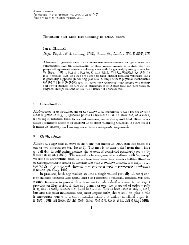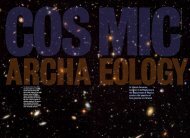Lecture Notes â Cosmology - UCL Astronomy Group
Lecture Notes â Cosmology - UCL Astronomy Group
Lecture Notes â Cosmology - UCL Astronomy Group
You also want an ePaper? Increase the reach of your titles
YUMPU automatically turns print PDFs into web optimized ePapers that Google loves.
1B23<br />
Modern Physics, <strong>Astronomy</strong>, and <strong>Cosmology</strong><br />
http://www.star.ucl.ac.uk/˜idh/1B23<br />
Partial <strong>Notes</strong>, <strong>Astronomy</strong> Set 3 – <strong>Cosmology</strong><br />
In 1929 Hubble established observationally that the Universe is expanding. Recall Hubble’s law:<br />
v = H 0 d<br />
(where v is the velocity of recession, d is the distance, and H 0 is ‘Hubble’s constant’, ca.<br />
70 km s −1 Mpc −1 ).<br />
[Because the value of H 0 was, until fairly recently, quite poorly known (of order 100 km s −1 , but factor<br />
∼2 uncertainty!), it has often been parameterized as<br />
H 0 = 100h km s −1<br />
Mpc −1<br />
Thus, for example, if a cosmological redshift of 500 km s −1 is measured for a galaxy, its distance may be<br />
expressed as<br />
d = v/H 0 = v/(100h) = 5h −1 Mpc.<br />
The last few years have seen a growing consensus that H 0 ≃ 70 ± 5 km s −1 (i.e., h ≃ 0.70 ± 0.05), through<br />
projects such as the HST Key Programme, Supernova <strong>Cosmology</strong>, WMAP etc.]<br />
The expansion of the universe implies that at some time in the past everything was in the same vicinity.<br />
Suppose some galaxy, distance d, has been receding from us since the Big Bang with its current observed<br />
velocity (a very rough approximation). Then it has taken the age of the universe, t 0 , to get to that<br />
distance, so<br />
d ≃ vt 0 ;<br />
but<br />
whence<br />
v = dH 0<br />
t 0 ≃ H −1<br />
0 ≡ τ 0<br />
where the ‘Hubble time’, τ 0 , is roughly the age of the Universe (more precisely, it is the time required for<br />
the Universe to double its size at the current expansion rate).<br />
It’s of interest to note that Hubble estimated H 0 = 530 km s −1 Mpc −1 . This gives<br />
τ 0 =<br />
9.77 × 1011<br />
yrs ≈ 2 × 10 9 yr<br />
530<br />
– implying that the age of the Universe is less than the age of old rocks!<br />
We believe that the ‘Hubble Flow’ shows that the Universe is expanding from a ‘Big Bang’ event early in<br />
its history. There is considerable additional evidence for the Big Bang, including:<br />
• The Cosmic Microwave Background<br />
• Primordial abundances of light elements<br />
• Evolution of source counts
The microwave background<br />
In 1965 Penzias and Wilson, engineers at Bell Laboratories, accidentally discovered the cosmic microwave<br />
background (CMB) – microwave ‘noise’ characterized by a black-body temperature of 3K and uniformly<br />
distributed across the sky. Penzias and Wilson got the Nobel Prize for this discovery (while the<br />
astrophysicist Robert Dicke, who told them what it was they’d discovered, who’d already conducted<br />
experimental searches for cosmic background radiation that had just failed to detect the 3K radiation, and<br />
who was in the process of building a new experiement which would’ve made the discovery, got nothing).<br />
The natural interpretation of the evolution of the Universe is that it had some phase when it was<br />
extremely compact and hot; that it has exapnded from that state in (very loosely speaking) an<br />
‘explosion’; and that the ‘3K’ background is the remnant of the explosion.<br />
Up to 10 5 yr after the Big Bang, the Universe was filled with high-energy photons which kept the matter<br />
(mostly hydrogen) ionized, and the Universe opaque (because free electrons have a large photon<br />
scattering cross-section).<br />
Eventually, when the temperature fell to ∼3000K, electrons and nucleons combined to form atoms. The<br />
coupling between radiation and matter ceased (H atoms interact with photons at a much lower rate than<br />
free electrons).<br />
The Universe then became transparent; the CMB represents the ‘last scattering surface’ that photons<br />
saw, an carries an image of the Universe when it was one thousandth of its present size 1 (and about one<br />
hundred thousandth of its present age).<br />
Observations, notably with the COBE satellite, have shown that, after corrections for local motions, the<br />
background is highly isotropic (to 1 part in 10 5 !) on large scales; it is indistinguishable from black-body<br />
radiation characterized by T = 2.725 ± 0.001K; and has it has low-level small-scale structure (on ∼ 1 ◦<br />
scales), studied in detail by the BOOMERanG and WMAP experiments. The precision of present-day<br />
observations, particularly of the small-scale structure, allows strong constraints to be placed on<br />
cosmological models.<br />
Cosmic abundances<br />
All stars in our galaxy, and throughout the nearby universe, appear to be formed from an initial<br />
composition which is ∼76% H, 24% He by mass. This ‘primordial’ composition appears to be universal.<br />
It is therefore natural to suppose that this composition is a consequence of initial conditions in the<br />
Universe; and indeed, early on in the Big Bang conditions were right for proton-proton chains to occur –<br />
exactly the same hydrogen fusion process that we have seen occurs in the cores of solar-type stars.<br />
Observed H/D/He/(Li) abundances provide strong constraints on the evolution of the Universe (while all<br />
heavier elements have formed subsequently, in stars).<br />
At an age of 100 s, the Universe had cooled to 10 9 K and D, He and Li were synthesised from the plasma.<br />
At higher temperatures, high energy gamma rays broke up any deuterium, inhibiting nucleosynthesis.<br />
When the Universe reached an age of 1000 s, all nucleosynthesis stopped as the temperature was then too<br />
low (6×10 4 K).<br />
The standard model of the Big Bang can account for the observed primordial abundances of He, D and Li<br />
for a specific value of the density of ordinary (baryonic) matter in today’s universe. This is because the<br />
baryonic density now is related to the baryonic density at the time of nucleosynthesis, and the baryonic<br />
density at that time determined the amount of deuterium (and, less sensitively, helium) produced –<br />
loosely speaking, the higher the density, the more deuterium. So by observing the ratio of deuterium to<br />
hydrogen atoms today, we infer the baryonic density at the time of nucleosyntheses, and hence the<br />
baryonic density today.<br />
Evolution of source counts<br />
If a set of sources of the same luminosity L is distributed with number density n (per unit volume) then<br />
the number of sources per unit solid angle to distance r is<br />
N(r) = 4πr3<br />
3 . n<br />
4π = nr3<br />
3<br />
1 What is ‘the size of the Universe’ The answer is that it is very probably infinite. Usually, however, when we talk about ‘the size of the Universe’, we
and their brightness is greater than l ∝ L/r 2 (i.e., r 2 ∝ L/l). The number brighter than l is thus<br />
N(l) ∼ nL3/2<br />
l 3/2<br />
We have to make corrections because of the Doppler shift in spectral-energy distributions (so-called K<br />
corrections). After this, we find that oberved source counts do not follow the expected N ∝ l −3/2 trend.<br />
Typically, for many classes of extragalactic sources, there were more in the past than now; for example,<br />
there are no quasars in the nearby universe, but many at redshift 1. This constitutes powerful evidence<br />
for an evolving universe.
THE DYNAMICAL EVOLUTION OF THE UNIVERSE<br />
We know that the Universe is expanding (the ‘Hubble Flow’); what are the details<br />
In 1915 Einstein published his General Theory of Relativity. In seeking solutions to his General<br />
Relativity equations that described the entire Universe, Einstein (wrongly) assumed that the Universe<br />
was static. Because the natural tendency for any group of bodies (such as galaxies) is to fall together<br />
under gravity, Einstein was therefore compelled to introduce a ‘cosmological constant’ term – essentially,<br />
a repulsive force to counteract the tendency of gravity to collapse the Universe. On hearing of Hubble’s<br />
demonstration that the Universe is expanding, Einstein is reported (perhaps apocryphally) to have called<br />
the cosmological constant his ‘greatest blunder’.<br />
In 1922 Alexandr Friedmann produced the first GR solutions for a dynamic Universe. The ‘Freidmann<br />
equation’ embodies the dynamical evolution of the Universe; we give it for completeness (and not because<br />
you’re expected to remember it!):<br />
Ṙ 2 (t) = 8πGρR2 (t)<br />
3<br />
− kc 2 + Λ 3 R2 (t).<br />
where R is the ‘scale factor’ (characterizing the distance separating two galaxies compared to the<br />
separation now), ρ is the density, k is the so-called ‘curvature term’, discussed below, and Λ is the<br />
cosmological constant term. (G, π, and c have their usual meanings.) The units employed by<br />
cosmologists are such that k is normally allowed only to take values 0 or ±1<br />
We can consider the Big Bang in terms of a traditional explosion (a simplifying, but dangerous, picture –<br />
don’t forget that the Bang didn’t occur at one place, but everywhere, in a probably infinite<br />
universe. . .which is still infinite, but bigger. . .). This doesn’t give us the full picture, but it does allow us<br />
to identify three straightforward possibilities:<br />
(i) If the explosion is powerful enough, it will hurtle galaxies apart with such force that gravity will never<br />
pull them together again. The universe will expand forever – an open universe (curvature term k = −1).<br />
(ii) If the explosion is weak, gravity will eventually bring galaxies back together. The universe will<br />
collapse in a ‘Big Crunch’ – a closed universe (curvature term k = +1).<br />
(iii) For the special intermediate case, the rate of expansion will forever slow under gravity, but will only<br />
come to a halt after infinite time – a critical universe (curvature term k = 0).<br />
These models can, in principle, be distinguished by the rate at which the expansion is changing with<br />
time, which can in turn be determined by the rate of recession of very distant sources – naively, we<br />
expect gravity to be slowing down the rate of expansion, so the most distant sources (seen not as they are<br />
now, but as they were at an early stage of the Universe) should be receding ‘too fast’.<br />
The deceleration of the universal expansion due to the gravitational influence of the matter content of the<br />
Universe is characterized by the ‘deceleration parameter’,<br />
q 0 = Ω/2 = 4πGρ/3H 2 0<br />
(from the Freidmann equation, neglecting the cosmological constant term).<br />
The density parameter, Ω was originally intended to characterize the density of matter in the Universe<br />
compared to the density needed to give a critical universe. From the Friedmann equation, the critical<br />
density is<br />
ρ crit = 3H 2 0 /8πG = 8 × 10 −27 kg m −3<br />
(for H 0 = 70 km/s Mpc −1 ).<br />
The Ω parameter is now used to describe the entire mass–energy content of the universe (including the<br />
cosmological constant), and the matter content is designated Ω M .<br />
If the Universe is of sufficiently high density (Ω M > 1), the force of gravitational attraction is enough halt<br />
the expansion and the Universe collapses in a ‘Big Crunch’.<br />
Ω M < 1 for an open universe that will continue to expand forever (Ω M = 0 is a universe containing no<br />
matter at all).
Ω M = 1 is a critical-density universe that will come to a halt after infinite time (and is geometrically flat;<br />
see below).<br />
If t 0 corresponds to the present age of the Universe, then for H 0 = 70 km/s Mpc −1 :<br />
Ω M = 0 gives t 0 = 1/H 0 ≃ 1.4 × 10 10 yr<br />
Ω M = 1 gives t 0 = (2/3)/H 0 ≃ 0.9 × 10 10 yr<br />
Ω M = 2 gives t 0 = 0.57/H 0 ≃ 0.8 × 10 10 yr<br />
Primordial nucleosynthesis and observational limits on the present-day deuterium abundance gives a limit<br />
on the baryon content, ρ B , of about 4% of ρ crit ; i.e, Ω B = 0.04.<br />
We know that there is also dark, non-baryonic, matter (recall: rotation curves of spiral galaxies, masses of<br />
clusters of galaxies). We believe that there is about 10 times as much dark as visible matter; i.e., in total,<br />
Ω M ≃ 0.3 from observations.<br />
For Ω M = 0.3, ρ M = 1.2 × 10 −27 kg m −3 .<br />
The energy density of 3 K cosmic background microwave radiation (CMB), expressed as a mass<br />
(E = mc 2 ), is ρ R = 4.5 × 10 −31 kg m −3 . (Stars contribute about the same radiation density – fewer<br />
photons, but each more energetic on average.)<br />
Because ρ M >> ρ R , the present-day universe is said to be matter dominated (although the number of<br />
photons exceeds the number of nucleons by a factor of about 10 9 ).<br />
In the early Universe, the reverse was true (radiation dilutes faster than matter, because radiation<br />
appears to lose energy by being red-shifted); the early Universe was radiation dominated.<br />
However, we have a potential problem – for Ω M > 0 (i.e., for a Universe that isn’t completely devoid of<br />
matter!), the implied age of the universe is less than the age of the oldest observed stars!<br />
Geometry of the Universe<br />
According to General Relativity, the geometry of space-time is also determined by the mass density (more<br />
properly, the mass–energy density) in the Universe. There are 3 possible geometries, determined by Ω,<br />
and related to the curvature parameter:<br />
• Ω > 1: the geometry is closed and spherical (the sum of the angles of a triangle > 180 ◦ ); k = +1.<br />
• Ω = 0: the geometry is open and hyperbolic (the sum of the angles of a triangle < 180 ◦ ); k = −1.<br />
• Ω = 1: the geometry is flat (Euclidean space, with the sum of the angles of a triangle = 180 ◦ );<br />
k = 0.<br />
Recent Results<br />
So what is the density parameter What is the future fate of the Universe Recent results give the<br />
surprising answers<br />
• Small-scale structure in the CMB<br />
The large-scale structure in the present-day universe (i.e., the distribution of galaxies in space; see<br />
later notes) can be mapped back to a prediction of the length scales of structure in the cosmic<br />
microwave background. Translating that linear scale into an observed angular scale depends<br />
sensitively on the geometry of space. Results from BOOMERanG and WMAP show that Ω (total)<br />
is within a few per cent of 1 – the Universe has a flat, Euclidean geometry.<br />
But we know, from primordial nucleosynthesis, that ordinary (baryonic) matter accounts for only<br />
Ω B ≃ 0.04, and all matter (baryonic plus ‘dark matter’) only Ω M ≃ 0.3. What makes up the other<br />
70% (since we know that radiation has a negligible role)<br />
• Supernova <strong>Cosmology</strong><br />
When we look at very distant galaxies, we see them as they were in the past. If gravity is slowing<br />
the rate of expansion of the universe, then in the past those galaxies were moving faster. If we can
measure the velocities of, and distances to, remote galaxies reliably, then we can measure the rate<br />
of change of velocity with time (i.e., we can determine the deceleration parameter).<br />
Determining distances accurately is difficult, but is possible by using supernovae as ‘standard<br />
candles’. The results from ‘supernova cosmology’ are stunning – the universe is not slowing down,<br />
but speeding up!<br />
What can cause this We believe that the answer lies with Einstein’s Cosmological Constant (or<br />
something closely related to it), which he introduced to counter the force of gravity. This<br />
cosmological constant represents the (non-zero) energy density of the vaccuum – popularly known<br />
as the ‘dark energy’ (by analogy with ‘dark matter’; we know almost nothing about either!).<br />
We believe that the dark energy, designated Λ, contributes about 70% of the total mass-energy content of<br />
the universe. Our final inventory is, therefore:<br />
Ω Tot = 1 – the universe has a flat geometry, and is made up of:<br />
Ω B ≃ 0.04 – familiar matter accounts for 4% of the stuff of the universe<br />
Ω M ≃ 0.3<br />
Ω Λ ≃ 0.7<br />
The dominance of the dark energy over matter implies that the rate of expansion of the universe will<br />
increase exponentially in the future.
Problems with the Big Bang model<br />
The Big Bang model is successful in accounting for the evolution of the Universe from 0.01 sec to the<br />
present time. The observational evidence that support this model includes:<br />
(1) The uniform expansion of the Universe.<br />
(2) The Cosmic Microwave Background (CMB).<br />
(3) The primordial abundances of D, 3 He, 4 He and 7 Li.<br />
But there are, nonetheless, problems that indicate that the Big Bang model is incomplete. These include:<br />
(1) HORIZON PROBLEM<br />
Two regions separated by less than ct are within their mutual horizon; they can communicate with each<br />
other in time t. Regions more than ct apart are outside the horizon and so cannot communicate.<br />
For the CMB, the horizon corresponds to 1 ◦ ; i.e., regions separated by > 1 ◦ should have different<br />
temperatures since they cannot communicate.<br />
The CMB is extremely uniform on large angular scales; how could well-separated regions ‘know’ that<br />
they had to end up looking the same in all directions<br />
(2) FLATNESS PROBLEM<br />
Why does the Universe have Ω = 1, when it could have taken any value at all → This implies the only<br />
stable value for Ω is 1.<br />
(3) STRUCTURE PROBLEM<br />
What was the origin of the fluctuations from which galaxies and the large scale structure of the Universe<br />
formed<br />
Density perturbations grow so slowly in an expanding Universe that there have to be some ‘seed’<br />
fluctuations in the very early Universe to produce the large scale structures we see today. Where did<br />
these ‘seeds’ come from<br />
(3) MONOPLE PROBLEM<br />
As the universe cooled, successively less massive particles should ‘freeze out’ of the matter-energy soup.<br />
This should lead to a significant population of very massive particles predicted by advanced (Grand<br />
Unified) theories, and exemplified by magnetic monopoles. These are not observed – where are they<br />
The answer to all these problems lies in a new ingredient: inflation.
THE INFLATIONARY UNIVERSE<br />
The idea of an inflationary Universe was first proposed in the Western world by Alan Guth, in 1982 (and<br />
by Linde and Starobinsky in the soviet world at around the same time, or slightly earlier).<br />
The central premise is that the Universe expanded at an exponential rate in its very early history,<br />
increasing in size (scale factor) by an enormous factor in its very early stages. There are a number of<br />
variations on the basic inflationary theory, but they share many basic characteristics.<br />
The inflationary era occured between t = 10 −35 and 10 −32 sec, during which the size of the Universe (i.e.,<br />
the size of that part of the Universe that is observable today) increased from 10 −23 cm to 10 cm.<br />
To produce a theory explaining why inflation occurs, it’s therefore necessary for all known physics to be<br />
extrapolated back from to 10 −35 s – a realm of very high energies (> 10 14 GeV) and temperatures (10 27<br />
K).<br />
Near this ‘beginning’, Quantum Theory meets the General Theory of Relativity; we have no knowledge of<br />
what happens before this time, which is called the Planck time, t = (Gh/c 5 ) 1/2 = 10 −43 sec. This is called<br />
the Quantum Gravity era; there is currently no theory of Quantum Gravity (GR is a field theory).<br />
Theories of particle physics aim at unifying the forces of nature. Maxwell unified electricity and<br />
magnetism into electromagnetism; Weinberg and Salaam unified electromagnetism and the weak force<br />
into the electroweak force. ‘Grand Unified Theories’ (GUTs; they exist, but there are many, and none is<br />
accepted as ‘the’ theory) unify the electroweak and strong forces. The greatest challenge is to incorporate<br />
gravity – this would be a Theory of Everything (TOE).<br />
In GUT theories, at 10 −35 sec, the strong nuclear force separated from the electroweak force. This phase<br />
transition or symmetry-breaking led to a period of inflation when the gravitational field became negative<br />
and acted as a repulsive force – inflation.<br />
Eventually the energy locked in during this process is released → hot unified soup of particles/energy →<br />
Universe expands as a power-law instead of exponentially (i.e., inflation then joins onto traditional Big<br />
Bang theory)<br />
PROBLEM (1): regions that were originally very close together are separated exponentially rapidly by<br />
the inflationary expansion. Thus causally connected regions (i.e. those < ct) are swept beyond their local<br />
horizons by the inflationary expansion.<br />
PROBLEM (2): The very fast expansion has the effect of straightening out the geometry of the Universe<br />
so that when the inflationary period ends, the geometry is flat, i.e., the curvature radius grows<br />
exponentially so that it becomes enormous compared to the Hubble radius of the Universe today.<br />
PROBLEM (3): The seeds of structure formation are supposed to have been formed by quantum energy<br />
oscillations during the quantum gravity era. One prediction of inflation is that the size of fluctuations in<br />
the CMB is the same on all angular scales because of the very rapid expansion.<br />
COBE and WMAP searched for temperature fluctuations in the CMB on angular scales of 10 ◦ and above<br />
and found a single level of fluctuations at 1 × 10 −5 . This finding therefore strongly supports the theory of<br />
inflation (but does not prove it).<br />
PROBLEM (4): If monopoles freeze out before inflation, they are diluted to a density of fewer than one<br />
particle per observable universe.
FORMATION OF STRUCTURE IN THE UNIVERSE<br />
Today we see galaxies, clusters of galaxies and superclusters. How did these structures form<br />
COBE and WMAP have found density fluctuations in the CMB (δρ/ρ = 1 × 10 −5 ). When the Universe<br />
becomes matter-dominated, these density inhomogeneities are amplified by gravity into the structures we<br />
see today. This amplification cannot happen until radiation-matter decoupling because radiation<br />
interacts with the matter.<br />
There is a major problem with this basic picture: the observed fluctuations are too small. If only<br />
ordinary baryonic matter exists in the Universe, the level has to be ∼ 10 −3 for there to be sufficient time<br />
to form the observed structures.<br />
The solution is non-baryonic dark matter (DM) which only interacts gravitationally. Thus large unseen<br />
fluctuations can be present prior to matter-radiation decoupling. When decoupling occurs, the baryonic<br />
matter falls into the deep gravitational wells of DM and structures are created.<br />
The way in which the structures are created depends on whether the DM is ‘cold’ (slow-moving) or ‘hot’<br />
(relativistic).<br />
Cold Dark Matter (CDM) – hypothetical massive, slow moving exotic particles with names like axions,<br />
gravitinos, photinos, or, generically, WIMPs (Weakly Interacting Massive Particles).<br />
Hot Dark Matter (HDM) – fast moving particles (e.g., neutrinos) with a small rest mass (< 10 eV).<br />
CDM evolution – fluctuations collapse and form galaxies first and then clusters and superclusters i.e.<br />
from bottom up.<br />
HDM evolution – fine scale structure (galaxies) is obliterated by free-streaming of fast-moving neutrinos<br />
and large scale structure forms first, and the galaxies form by fragmentation i.e. from top down.<br />
The nature of dark matter remains largely unknown, but numerical simulations of structure formation<br />
strongly favour cold dark matter.
Appendix: A Brief History of the Universe<br />
Epoch Time Main events<br />
after Big Bang<br />
Radiation Era (ρ R > ρ M )<br />
Planck 0–10 −43 s unknown physics;<br />
quantum gravity<br />
GUT 10 −43 –10 −35 s Strong, weak and EM forces unified; gravity freezes out<br />
Hadron 10 −35 –10 −4 s strong and weak forces freeze out<br />
Lepton 10 −4 –10 2 s Only light particles still in thermal equilibrium<br />
Nuclear 10 2 s–10 3 yr Deuterium and helium formed,<br />
(1yr = 3.16×10 7 s) in the first few minutes<br />
Matter Era (ρ R < ρ M )<br />
Atomic 10 3 –10 6 yr Matter dominates. Atoms form, leading to<br />
the CMB forming at ∼ 3 × 10 5 yr<br />
Galactic 10 6 –10 9 yr Galaxies and superclusters form.<br />
Stellar 10 9 –1.4 × 10 10 yr All galaxies have formed. Stars continue to form.<br />
Jeremy Bentham born, died, stuffed











